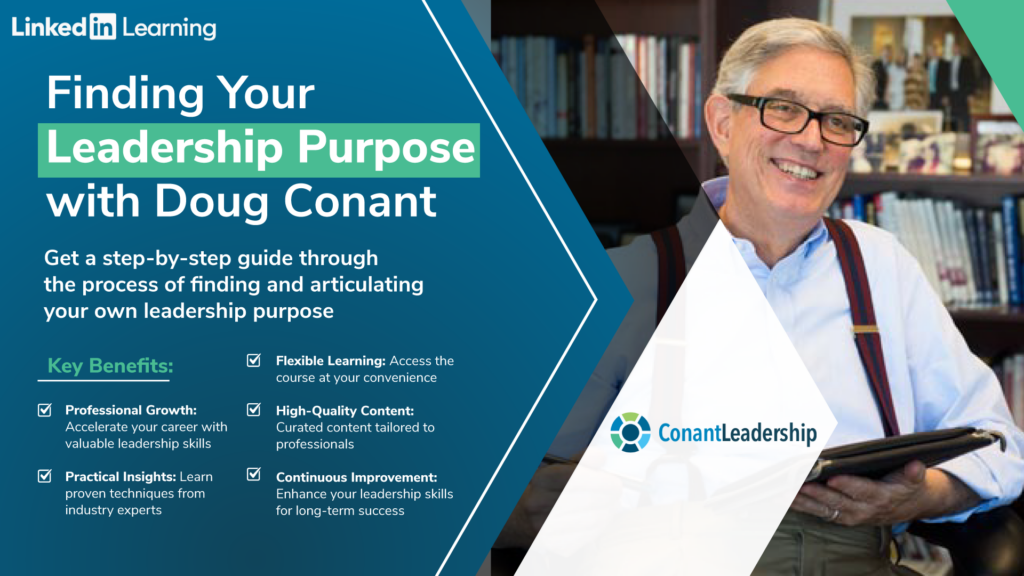The Right Way to Fail, How to Be More Persuasive, & More – The Leadership That Works Newsletter
At ConantLeadership, we’re committed to lifelong learning and continuous improvement. In service to your leadership growth, each month we curate the Leadership That Works Newsletter, a digest of timely resources from around the web. We prepare this resource in order to:
- Share actionable advice from top leadership luminaries
- Celebrate a range of viewpoints (inclusion is not an endorsement)
- Contextualize workplace trends through a leadership lens
- Illuminate cultural recalibrations in the world of work
- Support your personal development in life, leadership, and beyond
In this month’s Leadership That Works Newsletter: The right way to fail, how to be more persuasive, why vacation is good for your career, tips for developing resilience, and more. As always, we’re sharing the content from our newsletter here on our blog in case you’re not subscribed to our mailing list. If you find these links enriching, you can sign up to receive our newsletter right here.
The Right Way to Fail
**For more from Edmondson, explore our post, “Doug Conant and Amy Edmondson on How to Harness the Power of Psychological Safety.”
5 Ways to Be Much More Persuasive
1. Turn actions into identities. “‘Category labels’ give a sense of stability. They imply a behavior will persist.” For example, it’s more powerful to say you are a runner, rather than you go running, or to say you’re “a hard worker,” rather than, “hard working.”
2. Be concrete. The more specific your language, the more persuasive: “Research shows using concrete language increases attention, support, and drives action.” For example, a customer service rep is more credible when they say, “Let me go find that shirt in gray,” rather than, “I’ll go look for that.”
3. Convey confidence. Communication is more influential when it eliminates hedging and hesitation. For example, swap out “maybes,” and “kind ofs,” for words like “definitely and clearly,” and reduce your “‘ums,’ ‘ahs,’ and ‘like, you knows.'” Then, make recommendations in the present tense; talk about findings and observations in the here and now, rather than talking about what you “found” or observed in the past.
4. Ask more questions. Research shows that asking questions “makes people more likable,” especially in first impressions. The best type of question is the follow-up question because “it shows you care and proves you’re paying attention.” In work environments, some “limit questions because they don’t want to sound ignorant,” but the opposite is true: asking questions “makes you seem more competent.”
5. Talk to yourself. The more self-assured you are, the more persuasive you will be. Research shows hyping yourself up by literally talking to yourself can help e.g., saying “you can do this,” rather than “I can do this,” in your inner monologue. Another variation of effective self-talk is assuming desired behaviors as identities e.g., saying “I don’t have three glasses of wine,” versus “I can’t.”
Find a richer explanation of each tip and more examples in the full story here.
Vacation Is Good for Your Career
*For more on this, explore our newsletter archive which includes many related links about the ROI of employee wellbeing and work-life balance.
An Entrepreneur’s Tips for Resilience after Rejection
1. Not all feedback is created equal. While advice can be helpful, don’t listen to all of it: “Always be discerning, especially if the feedback feels off, uninformed, or unrealistic,” and focus primarily on “what comes from people who have actually done what you are doing,” and who have “real-world, hands-on experience.”
2. Be patient. When “pitching to potential decision-makers, the initial silence can be deafening,” but it helps to remember “no one cares more about our project than we do,” so “others will not place the same level of urgency” on reviewing it. It’s wise to “balance persistence with patience and grace.”
3. Perseverance pays. Put in the work to refine and improve your offerings: “Your barometer for what’s your ‘best’ is yours alone, but excellence takes refinement and experience,” so practice, hone, rewrite, rethink, and put forth your “very best effort.”
4. Use rejection as fuel. Although it’s hard to hear “no” repeatedly, every no is “one step closer to a yes,” and “the fastest track to failure is giving up.” Try to treat rejection as “clarity,” which is better than the uncertainty of no response at all—and let it “propel you forward.”
5. Lean on others. “Having a community is key,” as is the support of people who are in a similar situation or sector. Find a “stalwart group of people” to cheer you on and know that “their encouragement will be a balm for your soul.”
Get the full story here.
**For more on this, explore our post from the archives, “How to Build Leadership Grit.”
‘Inspired’ Employees Are the New ‘Engaged’ Employees’
**For more on this, explore two of our interviews with Stephen M.R. Covey, “A New World of Work Requires a New Way to Lead,” and “Tips from 3 Top Leadership Experts for Building Trust Post-Pandemic.”
Rookie Managers Are in Dire Need of Leadership Training
**For more on this, explore ConantLeadership’s suite of resources, courses, and training, designed by 45+ leadership veteran Doug Conant to empower leaders at every level to lift their game and maximize their impact.
‘Agreeableness’ Is a Competitive Advantage
Can DEI Leaders Solve Workplace Loneliness?
“Many organizations aren’t doing enough to address workplace loneliness,” writes Karen Perham-Lippman in this Senior Executive piece on the topic. She cites a body of research showing “an alarming increase in workplace loneliness,” which can lead to “severe health consequences such as increased risk of heart disease, stroke, dementia, anxiety, depression, and even premature death.” Given these risks, Lippman says leaders should view ameliorating workplace loneliness as “an urgent imperative that requires comprehensive organizational commitment,” and says that DEI leaders may be the right people for the job because they are “integral to fostering an inclusive, equitable, and engaged workforce.” And research shows workplace loneliness is “more prevalent among employees from underrepresented groups.” How should DEI leaders shape their strategy? First, they must “prioritize leadership practices that foster meaningful relationships. Then—
- “Take the time to understand employees and their needs.”
- “Recognize changes in behavior and provide necessary support.”
- “Listen to and show respect for employees.”
- “Focus on employee onboarding rather than orientation by going beyond ‘check the box’ activities.”
Get the full story and more tips for combatting workplace loneliness here.
*For more on forging deeper connections, explore our conversation with Brené Brown, “Empathy Is the Secret Source of Connection.”
Insights & Resources from ConantLeadership
Now Available! Our NEW LinkedIn Learning Course: “Finding Your Leadership Purpose with Doug Conant”
Our NEW LinkedIn Learning Course: “Finding Your Leadership Purpose with Doug Conant”
Purpose is essential. But it can be a nebulous concept. To help leaders find their own leadership purpose, Doug Conant developed a unique process, and a series of reflection prompts, for finding and writing your one-of-a-kind leadership purpose, which he is elated to share in his new LinkedIn Learning course. Access the course here.
‘The Power Is Inside of You’—How to Use Positive Leadership to Make a Difference
June‘s Leadership That Works Newsletter
 About the Author: Amy Federman is ConantLeadership’s Director of Content and Editor in Chief, and co-author with Doug Conant of the WSJ bestseller, The Blueprint.
About the Author: Amy Federman is ConantLeadership’s Director of Content and Editor in Chief, and co-author with Doug Conant of the WSJ bestseller, The Blueprint.

“Doug Conant is remarkable—and so is this work.“
– Stephen M. R. Covey
Author of The Speed of Trust

The Blueprint
6 Practical Steps to Lift Your Leadership to New Heights
By Douglas Conant with Amy Federman

Have Doug Speak at Your Event
Doug works collaboratively with event organizers to customize his material for each audience.



0 Comments